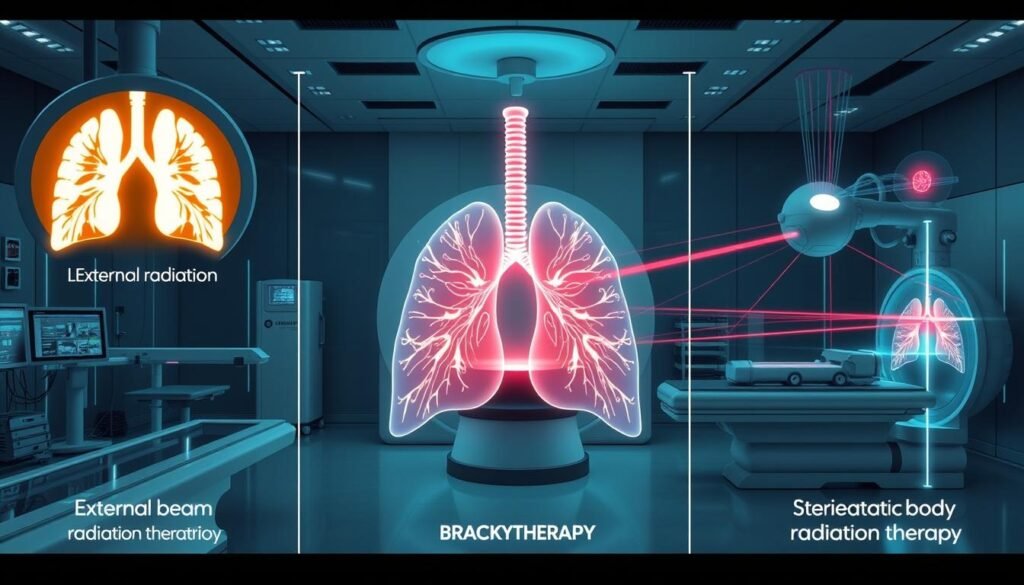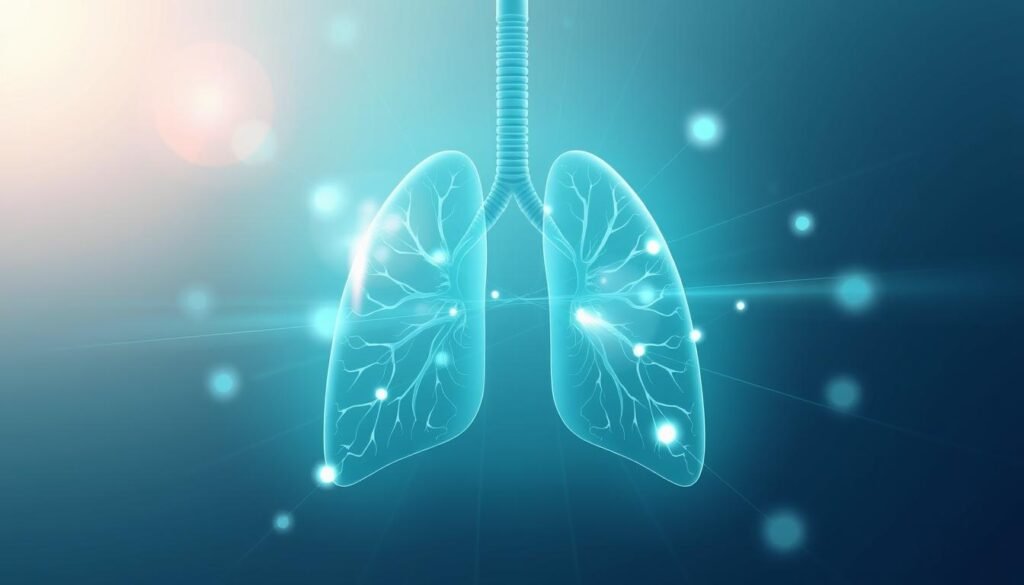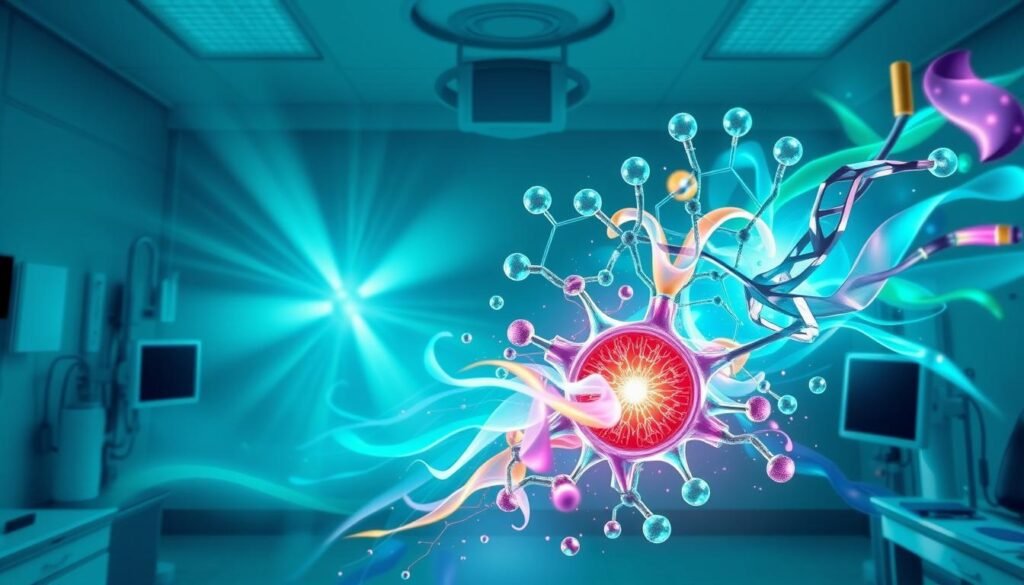Did you know over half of all cancer patients will need radiation therapy? This fact shows how important radiation is in treating lung cancer. It helps by targeting and killing cancer cells. So, it’s a key tool in battling this tough disease.
This article will cover different parts of radiation therapy. Readers will learn about its types, how it works, and what it means for patients. Knowing how radiation helps with lung cancer is crucial. It helps patients and their families make good choices. Radiation therapy can reduce symptoms and even help cure lung cancer in some cases. For more details, check out this in-depth guide.
Key Takeaways
- Radiation therapy is vital for lung cancer care.
- Techniques include external treatment and internal therapy.
- A team led by radiation oncologists designs the treatment.
- Side effects depend on where and how much radiation is used.
- Many see ongoing benefits from radiation after their treatment ends.
Introduction to Radiation Therapy
Radiation therapy is key in fighting lung cancer. It uses high-energy rays or particles to kill or slow the growth of cancer cells. There are many ways to give this therapy. The most common is external beam techniques. Sometimes, treatment is given internally through brachytherapy, targeting the cancer directly.
This therapy plays various roles in treating lung cancer. It might be the main treatment for those who can’t have surgery. It can also help after surgery to get rid of any remaining cancer cells. Or, it can ease symptoms in later stages of the disease.
There are advanced techniques in radiation oncology that offer better precision and effectiveness. For example, Intensity-Modulated Radiation Therapy (IMRT) and Volumetric Modulated Arc Therapy (VMAT) allow higher doses with shorter treatment times. 3-Dimensional Conformal Radiation Therapy (3D-CRT) uses 3D imaging to tailor the treatment plan to the tumor’s shape.
Image-Guided Radiation Therapy (IGRT) enhances targeting accuracy with high-resolution X-ray images. Stereotactic Body Radiotherapy (SBRT) gives large doses to small areas, preserving more healthy tissue. It uses systems like the CyberKnife® for even more accuracy.
Many patients see benefits from hypofractionated radiation therapy. This approach gives more doses in each session, shortening the total treatment time and reducing side effects. The flexibility of radiation therapy, and its use with other treatments like surgery and chemotherapy, highlights its importance in lung cancer care.
| Radiation Therapy Techniques | Description |
|---|---|
| External Beam Radiation Therapy (EBRT) | Targeted radiation from outside the body, treating many cancer types. |
| Brachytherapy | Internal radiation using radioactive seeds or implants at the cancer site. |
| Intensity-Modulated Radiation Therapy (IMRT) | Precise radiation delivery that shapes the dose around the tumor. |
| Stereotactic Body Radiotherapy (SBRT) | High doses of radiation to small areas, preserving surrounding healthy tissue. |
| Image-Guided Radiation Therapy (IGRT) | Enhances targeting accuracy through real-time imaging during treatment. |
| Hypofractionated Therapy | Fewer sessions with higher doses leading to quicker treatment completion. |
What is Lung Cancer?
Lung cancer is a major health issue caused by abnormal cell growth in the lungs. It mainly splits into two types: non-small cell lung cancer (NSCLC) and small cell lung cancer (SCLC). NSCLC makes up about 85% of all cases and grows slower than SCLC, which spreads quickly.
Many things increase lung cancer risk. Smoking is the biggest risk factor. Yet, environmental toxins, pollutants, and genetics also play a role. Being around secondhand smoke or working with dangerous materials like asbestos raises the risk too.
Knowing about lung cancer is key to finding the right treatment. In its early stages, it can cause a persistent cough, chest pain, and weight loss. These symptoms prompt doctors to look for cancer cells in the lung. This knowledge helps choose the best treatment, such as radiation therapy.
The Role of Radiation in Lung Cancer Treatment
Radiation therapy is key in treating lung cancer. It works well for different stages. It can be the main treatment for tumors that can’t be removed or help after surgery. The main aim is to kill or stop the growth of cancer cells in the lungs. It also helps ease the symptoms of late-stage lung cancer.
How Radiation Therapy Works
Radiation therapy fights cancer by damaging cancer cell DNA with high-energy beams. This leads to the death of these cells. It targets the bad cells and tries to protect the good ones. Knowing how it works can make patients feel better about getting this treatment.
Types of Lung Cancer Treated with Radiation
Different kinds of lung cancer, like NSCLC and SCLC, respond to radiation therapy. It’s a major treatment for patients who can’t have surgery or are in advanced stages. Studies show that it can relieve symptoms in patients with advanced NSCLC.
| Type of Cancer | Effectiveness of Radiation Therapy | Common Treatment Approaches |
|---|---|---|
| Non-Small Cell Lung Cancer (NSCLC) | High efficacy in palliative and curative treatment | External beam radiation therapy, brachytherapy |
| Small Cell Lung Cancer (SCLC) | Useful for symptom relief, particularly with prophylactic cranial irradiation | Radiation combined with chemotherapy in specific cases |
Types of Radiation Therapy
Understanding different types of radiation therapy is key in treating lung cancer effectively. Using various methods helps target cancer cells while saving healthy tissue. Options include external beam radiation, brachytherapy, and proton therapy for lung cancer. Each has its benefits, meeting the needs of different patients.
External Beam Radiation Therapy (EBRT)
External beam radiation therapy is often chosen for lung cancer. It uses radiation beams from outside the body, typically with a linear accelerator. This method targets the tumor precisely and is comfortable for patients. EBRT is done five days a week for six weeks.
Brachytherapy Techniques
Brachytherapy puts radioactive material close to or inside the tumor. This method delivers a high dose of radiation right where it’s needed. The techniques for brachytherapy can be adjusted to fit each patient. This guarantees the best possible outcomes.
Proton Therapy for Lung Cancer
Proton therapy is a cutting-edge option that uses protons, not X-rays. It’s great at sparing healthy tissues around the tumor. Proton therapy is a top choice for certain lung cancer patients. As the technology gets better, more people can benefit from these therapies, enhancing patient recovery.

Radiotherapy Techniques Explained
Radiotherapy techniques are key in improving lung cancer treatment. Different methods help target tumors accurately, protecting healthy tissue. Each method offers unique benefits, giving patients customized treatment choices.
Stereotactic Body Radiation Therapy (SBRT)
Stereotactic body radiation therapy is a big leap forward for lung cancer care. It gives high radiation doses in just one to five sessions. SBRT’s precision means doctors can aim at tumors and save the healthy tissue around them. Research shows that for those with early-stage, inoperable lung cancer, the rates of being disease-free and alive after three years are 48.3% and 55.8%.
The side effects are generally manageable, with a 16.3% rate for more serious issues.
Intensity-Modulated Radiation Therapy (IMRT)
Intensity-modulated radiation therapy is another cutting-edge radiotherapy approach. IMRT adjusts radiation strength to match the tumor’s exact shape and size. This is especially helpful when the cancer is close to vital organs, improving safety and effectiveness. With IMRT, doctors can treat cancer more precisely. This may lead to better control of the disease and less harm to healthy tissue.
3D Conformal Radiotherapy (3D-CRT)
3D conformal radiotherapy uses advanced imaging to create a 3D model of the tumor. This makes radiation beams fit the tumor’s shape perfectly. It boosts radiation to cancer cells while sparing normal tissue. This method is great for reaching tumors that are hard to get to, making treatment more effective and reducing side effects.
When is Radiation Therapy Used?
Radiation therapy is crucial in treating lung cancer. It comes into play when surgery isn’t an option. This can be due to the nature of the cancer or patient health issues. The choice of radiation and its timing hinges on cancer specifics and patient well-being.
In early-stage non-small-cell lung cancer (NSCLC), it can be the main treatment. It might also follow surgery to ensure thorough care. Using techniques like SBRT, doctors aim radiation accurately, protecting healthy tissue around the tumor.
Radiation also plays a key role in palliative care, easing symptoms like pain and breathing problems. It makes life more manageable for those with advanced lung cancer, addressing the physical hurdles they face.
Knowing when to use radiation therapy is vital. It helps in planning treatments and assists patients and their families in understanding lung cancer care.

Understanding Radiation Dosage in Lung Cancer Treatment
Finding the right radiation dose is crucial in treating lung cancer. Doctors look at the tumor’s size and where it is. They also check what kind of lung cancer you have. This helps them make a plan that kills cancer cells but saves healthy ones.
Determining the Right Dosage
To find the best dose, doctors weigh the benefits and possible side effects. Studies show 60 to 70 Gy works best for some who can’t have surgery. For those who can have surgery, the dose doesn’t really change the chances of living longer or facing early problems.
The dose is measured in Grays (Gy). The treatment is often spread out over many days. For example, stage I might get 54 Gy in three sessions. Stage III often needs 60 Gy across 30 sessions. Doctors can adjust the schedule to make treatment more effective without increasing the risk.
Knowing the best overall dose can make lung cancer treatment better. Research helps doctors find the right dose to balance treatment and results. Learn more about how doses are decided in cancer therapy here.
Possible Side Effects of Radiation Therapy
Radiation therapy helps treat lung cancer. But, it can also cause side effects. Knowing these effects helps people get ready for treatment. It makes the experience less scary.
Short-term Side Effects
Short-term side effects happen during radiation therapy. People often report:
- Fatigue
- Skin reactions, like redness and dryness
- Sore throat
- Coughing
- Shortness of breath
- Nausea or feeling sick
Difficulty swallowing is a common issue, especially with chest radiotherapy. This problem can make eating solid foods tough. Eating softer foods such as soups and yogurt helps. Stay away from foods that are hot, cold, or spicy, and don’t drink alcohol.
Long-term Side Effects
Long-term side effects can happen after radiation therapy. They depend on the dose and area treated. Issues might include persistent cough and lung damage. Shortness of breath often gets better after treatment. It’s important for patients to tell their doctors about any breathing problems right away.
Weight loss during treatment is common. Working with a dietitian can help find high-calorie foods and supplements. Medicine can help with pain from heartburn or discomfort. Most side effects go away a few months after treatment ends. But some can show up much later. Knowing these possible effects is important for patients.
| Side Effects | Short-Term | Long-Term |
|---|---|---|
| Fatigue | Common | May persist |
| Skin Reactions | Redness, irritation | Possible changes in sensitivity |
| Sore Throat | Yes | Difficulty swallowing may persist |
| Coughing | Yes | Possible long-term cough |
| Shortness of Breath | Yes | May develop into long-term difficulty |
| Hair Loss | Possible in treatment area | Usually regrows |
Managing Side Effects
Managing side effects makes life better for lung cancer patients, especially during radiation therapy. They often deal with tiredness, trouble eating, and feeling sick. Knowing about these effects helps in creating helpful care plans.
- Fatigue affecting around 80 percent of patients acutely
- Nausea, which may lead to vomiting
- Difficulty swallowing, impacting solid food intake
- Shortness of breath, potentially persisting for weeks to months
Talking to medical experts is key to handling these issues well. Exercise might ease tiredness, and medicines can combat nausea. Following certain eating plans can also keep up energy and comfort.
Using medicines like selective serotonin reuptake inhibitors may help with treatment-related sadness. Finding the best supportive care is crucial. Dieticians play a big role in improving what patients eat.
Good side effect management helps patients feel better and stick to their treatments. Talking openly with doctors is important. It helps find care that suits each person.
Combining Radiation with Other Treatments
Mixing radiation with other treatments can really help fight lung cancer more effectively. Studies show that when radiation therapy joins forces with chemotherapy, patients see better results. This is because people with non-small cell lung cancer (NSCLC) have different tumor types. These tumors respond differently to various treatments.
When doctors add immune checkpoint inhibitors to radiation therapy, patients with many tumor changes often live longer. This method fills important gaps since not all patients respond well to immunotherapy by itself. So, combining radiation with other treatments is a big step forward in fighting cancer. Since every patient’s tumor is unique, treatments must be customized. This customization depends on how likely it is that a treatment will work, based on the tumor’s genetic changes.
A study found that patients with low TMB but high aneuploidy scores respond better with extra treatments like radiation. This means creating more personalized treatment plans could greatly improve how long patients live. Researchers are working hard to make these treatment combinations even better. This supports the idea that mixing radiation with other treatments could lead to the best care for patients.

Importance of Lung Cancer Staging
Lung cancer staging is key in understanding how far the cancer has spread. It helps doctors plan the best treatment. Stages range from 0, meaning cancer has not moved, to stage IV, where cancer has spread a lot. Each stage tells doctors about cancer progression and what treatments might work best.
Lung cancer is mainly divided into two types, based on how they look under a microscope. Non-small cell lung cancer goes from stages 0 to IV. Small cell lung cancer is either limited stage, in one lung, or extensive stage, spread beyond. Tumor size, location, lymph node involvement, and whether cancer has spread (metastasis) determine the stage.
Sometimes, doctors need more info before they can plan treatment. They may look into lymph nodes to see if cancer has spread there. This helps them make a more focused treatment plan. What they find during surgery can also impact the treatment decisions moving forward.
Tools like CT scans and PET scans are really important for staging lung cancer. They show how big the cancer is and if it’s moved to other parts of the body. With this info, doctors can create treatment plans that are right for the patient’s cancer type and health.
Conclusion
Understanding radiation therapy is key in treating lung cancer. It’s vital for both non-small cell lung cancer (NSCLC) and small cell lung cancer (SCLC). It helps ease symptoms, better survival rates, and overall patient outcomes.
New techniques like stereotactic body radiation therapy (SBRT) and proton therapy have made big improvements. They work better and aim to lessen side effects. With today’s technology, radiation therapy is essential in lung cancer care.
Lung cancer is the top cause of cancer deaths worldwide, with nearly 160,000 deaths in the US in 2011. The median survival times for stage III NSCLC show the need for customized treatment plans. Using SBRT after chemotherapy can greatly increase survival chances. This shows how treatment options are changing.
Treating lung cancer with care and knowledge can greatly improve patient care. Advancements in radiotherapy help increase survival rates and help patients with their treatment paths. For more info on recent studies, click here.